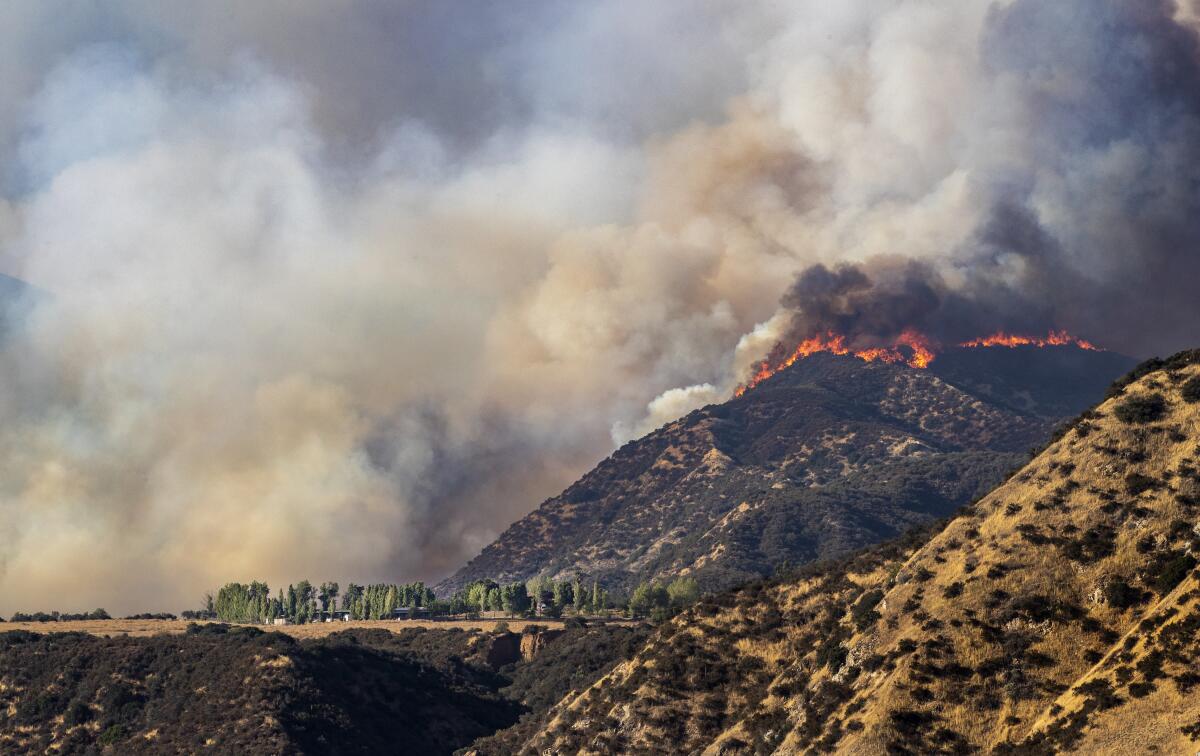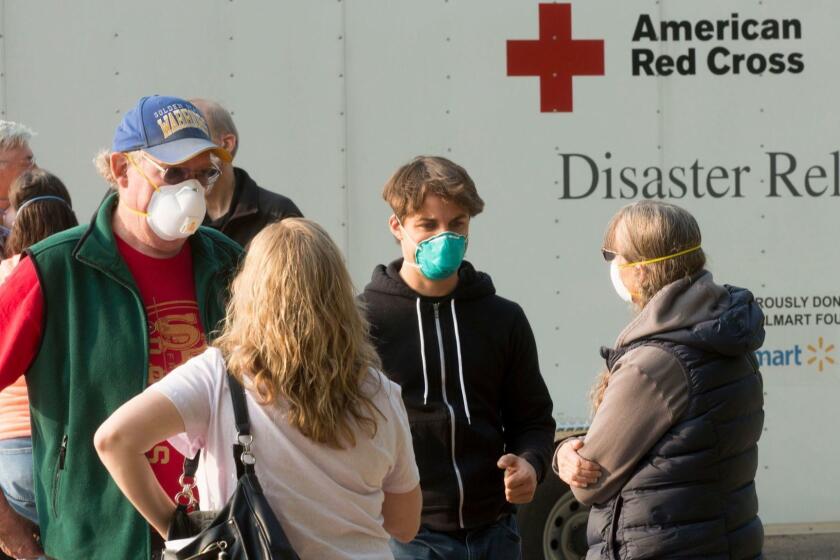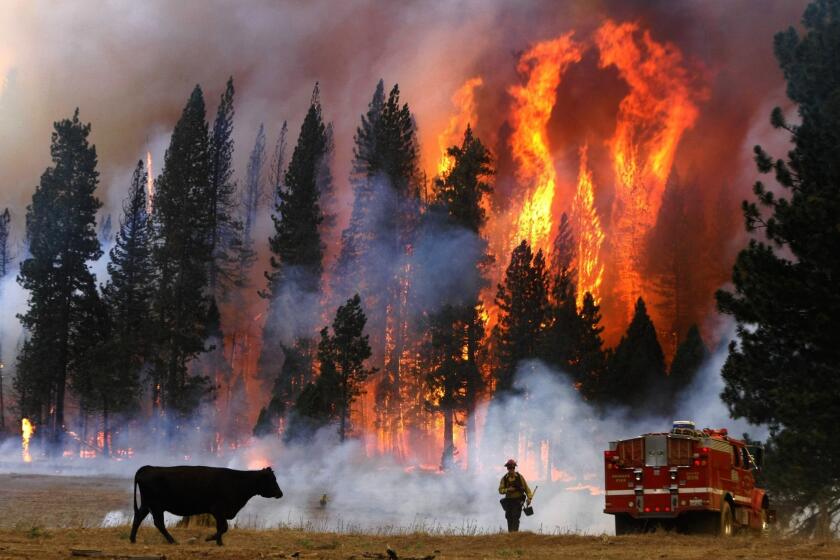Coronavirus fears complicate Apple fire evacuation plans

- Share via
As a massive pillar of smoke spewed ash and debris over the Inland Empire, Ken Reich found himself in the silent gymnasium of Beaumont High School, a designated evacuation center for the Apple fire. It was Monday morning, and the place was empty, despite orders from law enforcement for nearly 8,000 residents to flee their homes.
“This is an unusual situation for us,” the Red Cross spokesman said. “For the first time, we’re setting people up in hotels instead of a shelter, where coronavirus could be a real problem.”
With more than 26,000 acres scorched by the growing wildfire, emergency officials have been scrambling to avoid COVID-19 outbreaks among evacuees and firefighters. The decision to essentially abandon traditional evacuation centers has drastically altered a Southern California routine. Officials note that while it has historically been difficult to get residents to evacuate their homes in the face of approaching flames, the pandemic threatens to make the process all the more challenging.
With the threat of infection on many people’s minds, Reich said, the agency had “come up with a very expensive Plan B ... funded by the generosity of the American people.”
By the time fire season arrives, officials hope the spread of COVID-19 will taper off, but preparations are already being made.
As of Tuesday, 43 families had been sheltered in nine local hotels, with some averaging rates of more than $100 per night, a stark departure from previous years when panic-stricken families slept cot to cot and waited in food lines in crowded high school gymnasiums.
“At this time, the Red Cross is prioritizing emergency hotel lodging for evacuees, but we understand there may be a need to open congregate shelters at the request of local officials,” said Red Cross spokeswoman Jenelle Eli in an email.
Due to social distancing and other safety requirements, the evacuation center at Beaumont High School could house only 50 residents if the county were to run out of hotel rooms, said Shane Reichardt, spokesman for the Riverside County Emergency Management Department. Other schools and county facilities would open up if more space were needed.
“We’re always training for [a] worst-case scenario, this event that’s always got a lot of complexity and someone throws in a wild card in there,” Reichardt said. “We don’t want to ask for any more, but managing multiple incidents is not uncommon for us.”
How the coronavirus will influence people’s decisions to evacuate remains to be seen.
“People would rather be at home, especially older people who’ve lived in their communities and have seen what it goes through,” Reichardt said. “They feel like they know better than public safety officials.”
But in the wake of the Camp fire that killed 85 people in and around the town of Paradise in 2018, Reichardt said, “there’s a need to act quickly and get out when public safety officials are telling people.”
To that end, authorities are being more selective about whom they tell to leave. They are refining evacuation zones and notifying residents through traditional and social media channels and their app, Alert RivCo.
“In the past it was really just draw a box and say, ‘Get everyone out of there,’” Reichardt said.
Yet even with this new approach, there were still Apple fire holdouts. Reichardt said he has heard of people staying to protect their homes, their relatives and, in one case, a giant pet turtle.
On Monday, a group of neighbors from the small San Bernardino Mountain community of Oak Glen had remained despite evacuation orders. They said COVID-19 had little to do with their decision. Instead, they said they were staying so that they could defend their homes from fire.
They sat at picnic tables with a panoramic view of the fire as it crab-crawled down steep slopes, igniting a forest of incense cedars, oak trees and ponderosa and Coulter pines.
The village had survived numerous major wildfires over the last decade, and these residents figured their water resources, familiarity with local roads and spirit of independence would protect their homes and families.
“We’re going to stick it out,” said Devin Riley, 55, manager of Los Rios Rancho, an apple farm and country store operation on a nature preserve owned by the Wildlands Conservancy.
“A lot of folks up here are rural, independent types who have been through this before,” he said.
But officials are concerned that worries about COVID may keep even more residents away than usual.
“Even though the ‘COVID-19 is no big deal’ group is the most vocal, the people who have substantial concerns about it, they just stay home. I’m a little concerned ... they simply will not evacuate,” said Riverside County Health Officer Dr. Cameron Kaiser. “If someone gets an evacuation order, obey. The idea is that we’re going the extra mile to ensure them that their safety is being taken care of.”
The county has had a plan in place for evacuations during COVID for months, Kaiser said. The Red Cross too. Shelters will have more hand-washing stations, staggered meal times and less capacity to ensure social distancing. Residents who arrive and have COVID-19 symptoms are redirected to a different facility.
“Our interests are aligned here,” Kaiser said. “I don’t want you to get sick, you don’t want to get sick. The idea here is that if you get sick, it’s a failure of a system I’ve designed.”
A separate concern is notifying people when it’s time to return home. Only a fraction of the county is set up for alerts through Alert RivCo, Reichardt said.
As California’s wildfire season approaches, authorities are worried about their ability to muster a healthy firefighter force amid coronavirus crisis.
In the meantime, firefighters are battling the blaze while also navigating their own coronavirus precautions.
“In a non-coronavirus world, we wouldn’t be using our air resources this aggressively,” said Christine McMorrow, a California Department of Forestry and Fire Protection spokeswoman. “Does it mean that firefighting is more expensive now? We won’t know until we tally up the costs at the end of the fire season.”
New emergency response protocols were also devised this year for establishing camps used to house firefighters, the support personnel who assist in logistics and supplies, and inmates who help in clearing fire breaks.
“Our biggest concerns in a post-coronavirus world is safety at fire camps during these larger wildfires,” she said. “Things are more spread out and conducted in open air — and there are more hand-washing facilities.”
Evacuation protocols, however, remain unchanged.
“We work closely with local sheriff’s departments to make recommendations that take into account the status of a given fire and where fire activity is increasing,” she said. “But our overall concern when making recommendations about evacuations is the safety of human life and property — coronavirus or not.
“Most people would prefer to risk being exposed to coronavirus,” she added, “than to stay at home and risk being trapped in a wildfire.”
Though only about 1% to 3% of evacuees typically stay overnight at shelters, there are plans in place in which the Red Cross could rapidly shelter up to 5% to 10% of evacuees from a major incident by tapping a network of agencies to help steer residents to hotels, schools, churches and college dorms, said Denise Everhart, the Red Cross’ Pacific Division disaster executive.
“This is a new world for all of us, and this is challenging,” Everhart said. “And the way we’re overcoming it is making sure we have all the right partners and we’re all talking to each other.”
More to Read
Sign up for Essential California
The most important California stories and recommendations in your inbox every morning.
You may occasionally receive promotional content from the Los Angeles Times.













